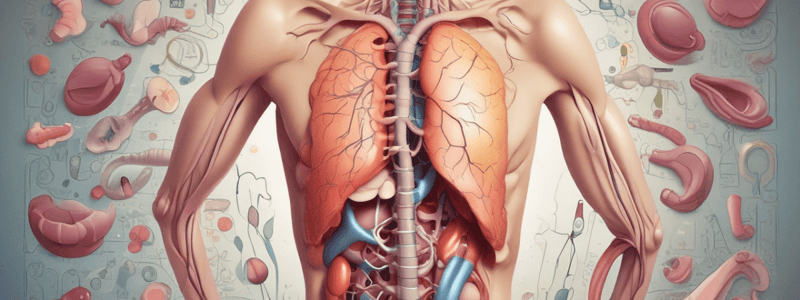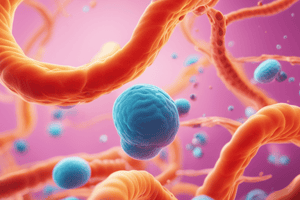Podcast
Questions and Answers
What is considered a precursor of gastric carcinoma and is difficult to see sonographically?
What is considered a precursor of gastric carcinoma and is difficult to see sonographically?
- Gastritis (correct)
- Intussusception
- Pyloric stenosis
- Peptic ulcer disease
Where do benign peptic gastric ulcers most often appear?
Where do benign peptic gastric ulcers most often appear?
- In the pyloric antrum
- Along the lesser curvature of the stomach (correct)
- In the fundus of the stomach
- Along the greater curvature of the stomach
What is a complication of peptic ulcer disease?
What is a complication of peptic ulcer disease?
- Obstruction
- Perforation (correct)
- Bleeding
- Inflammation
What can suggest the presence of peptic duodenal ulcers on sonography?
What can suggest the presence of peptic duodenal ulcers on sonography?
What is the typical sonographic appearance of gastritis?
What is the typical sonographic appearance of gastritis?
What is a characteristic sonographic feature of peptic ulcer disease?
What is a characteristic sonographic feature of peptic ulcer disease?
What is a rare cause of gastric dilatation?
What is a rare cause of gastric dilatation?
What is usually associated with pyloric muscle hypertrophy in adults?
What is usually associated with pyloric muscle hypertrophy in adults?
Which of the following conditions may bring about gastric dilatation as a complication of neuropathy?
Which of the following conditions may bring about gastric dilatation as a complication of neuropathy?
What can differentiate atonic from obstructive dilatation?
What can differentiate atonic from obstructive dilatation?
What is characterized by enlarged rugal folds with generalized thickening of mucosal layer of wall?
What is characterized by enlarged rugal folds with generalized thickening of mucosal layer of wall?
What is a variation of chronic gastritis?
What is a variation of chronic gastritis?
What may accompany thickening of mucosal layer of wall in chronic gastritis?
What may accompany thickening of mucosal layer of wall in chronic gastritis?
What type of polyps may be demonstrated in chronic gastritis?
What type of polyps may be demonstrated in chronic gastritis?
Which of the following is a potential complication of a posterior duodenal perforation?
Which of the following is a potential complication of a posterior duodenal perforation?
What is the primary characteristic of Crohn's disease that differentiates it from other inflammatory bowel diseases?
What is the primary characteristic of Crohn's disease that differentiates it from other inflammatory bowel diseases?
Which of the following is NOT a characteristic of free air in the peritoneal region?
Which of the following is NOT a characteristic of free air in the peritoneal region?
What is the main purpose of performing Endoscopic Ultrasound (EUS)?
What is the main purpose of performing Endoscopic Ultrasound (EUS)?
What is the most common outcome of an anterior gastric perforation?
What is the most common outcome of an anterior gastric perforation?
What is the typical appearance of free air in the peritoneal region on ultrasound?
What is the typical appearance of free air in the peritoneal region on ultrasound?
Which of the following is a potential complication of peptic ulcer disease?
Which of the following is a potential complication of peptic ulcer disease?
What is the primary cause of thickening of the bowel serosa in cases of peptic ulcer disease?
What is the primary cause of thickening of the bowel serosa in cases of peptic ulcer disease?
What characteristic appearance does a foreign body (FB) present in the acute phase?
What characteristic appearance does a foreign body (FB) present in the acute phase?
What causes clean shadowing in a foreign body on ultrasound?
What causes clean shadowing in a foreign body on ultrasound?
What develops around a foreign body 24 hours after the onset of the acute phase?
What develops around a foreign body 24 hours after the onset of the acute phase?
How does the appearance of an organic foreign body change during the intermediate phase?
How does the appearance of an organic foreign body change during the intermediate phase?
What is a common pitfall when evaluating a projectile foreign body?
What is a common pitfall when evaluating a projectile foreign body?
What aids in locating a foreign body during the sonographic examination?
What aids in locating a foreign body during the sonographic examination?
Which component in a metallic foreign body contributes to its echogenic properties?
Which component in a metallic foreign body contributes to its echogenic properties?
What effect does the inflammatory response have on the echogenicity of the foreign body?
What effect does the inflammatory response have on the echogenicity of the foreign body?
What sonographic characteristic distinguishes a foreign body in the acute phase from one in the chronic phase?
What sonographic characteristic distinguishes a foreign body in the acute phase from one in the chronic phase?
What is the typical sonographic appearance of a foreign body in the chronic stage?
What is the typical sonographic appearance of a foreign body in the chronic stage?
What is the body's response to wall off foreign material in the chronic phase?
What is the body's response to wall off foreign material in the chronic phase?
How can a foreign body in the chronic stage be easier to locate with sonography?
How can a foreign body in the chronic stage be easier to locate with sonography?
What sonographic finding suggests a foreign body is in the acute phase?
What sonographic finding suggests a foreign body is in the acute phase?
Which of the following is NOT a typical characteristic of foreign body appearance on sonography during the chronic phase?
Which of the following is NOT a typical characteristic of foreign body appearance on sonography during the chronic phase?
Which of the following statements is TRUE regarding the sonographic appearance of foreign bodies in the acute phase?
Which of the following statements is TRUE regarding the sonographic appearance of foreign bodies in the acute phase?
Which of the following is a characteristic sonographic finding of an acute injury to the plantar surface, indicating the presence of a foreign body?
Which of the following is a characteristic sonographic finding of an acute injury to the plantar surface, indicating the presence of a foreign body?
What sonographic characteristic differentiates a chronic foreign body from an acute foreign body?
What sonographic characteristic differentiates a chronic foreign body from an acute foreign body?
Which of the following is NOT a factor that influences the sonographic appearance of a foreign body?
Which of the following is NOT a factor that influences the sonographic appearance of a foreign body?
What is the sonographic appearance of a metallic foreign body in the acute phase?
What is the sonographic appearance of a metallic foreign body in the acute phase?
Which of the following is NOT a benefit of evaluating the inflammatory response surrounding a foreign body in the intermediate phase?
Which of the following is NOT a benefit of evaluating the inflammatory response surrounding a foreign body in the intermediate phase?
What is the primary advantage of using sonography to evaluate foreign bodies?
What is the primary advantage of using sonography to evaluate foreign bodies?
What does a hypoechoic halo surrounding a foreign body indicate?
What does a hypoechoic halo surrounding a foreign body indicate?
Which of the following factors can influence the sensitivity and specificity of sonography for foreign body detection?
Which of the following factors can influence the sensitivity and specificity of sonography for foreign body detection?
What is the primary purpose of evaluating the location of a foreign body?
What is the primary purpose of evaluating the location of a foreign body?
Study Notes
Pyloric Muscle Hypertrophy
- Rare in adults, typically linked to gastritis or ulcer disease.
Gastric Dilatation
- Caused by obstruction from tumor or ulcer disease at the gastric outlet.
- Additional contributors include diabetes mellitus, scleroderma, and complications from surgical vagotomy.
- Gastric peristalsis can help differentiate between atonic and obstructive dilation.
- Stomach wall rigidity suggests tumor infiltration or gastric ulcers.
- Uncoordinated peristalsis may be present in neuropathic conditions.
- Volvulus is a rare cause of gastric dilatation.
Gastritis
- An inflammatory disorder affecting the gastric mucosa.
- Chronic gastritis can lead to enlarged rugal folds and thickened mucosal layer.
- Associated with increased acid production (e.g., Zollinger-Ellison syndrome) or decreased acid (e.g., Ménétrier disease).
- May display hyperplastic and inflammatory polyps.
- Atrophic gastritis is characterized by thinned mucosa.
- Endoscopic ultrasound (EUS) is used to diagnose complications like ulceration.
Ulcer Disease
- Complications from peptic ulcers (gastric or duodenal) include perforations.
- Anterior perforations lead to free intraperitoneal air and can cause peritonitis.
- Free air in the peritoneal region is identified by increased echogenicity; important to differentiate from bowel gas.
- Thickening of bowel serosa may indicate peritoneal irritation and reactive edema.
- Complications include bleeding from posterior duodenal perforation and potential pancreatitis from posterior stomach perforation.
Gastroduodenal Crohn Disease
- Idiopathic inflammation starting in the submucosa, affecting all bowel wall layers.
- Chronic condition, primarily occurs in young adults and may be a precursor to gastric carcinoma.
Peptic Ulcer Disease (PUD)
- Defined as a break or ulceration in the protective mucosal lining of the esophagus, stomach, or duodenum.
- Benign gastric ulcers often appear along the antral portion of the lesser curvature.
- Sonographic findings may show significant wall thickening due to submucosal edema with milder gastric mucosa thickening.
- Difficulties in identifying peptic duodenal ulcers are common, but mucosal edema can indicate their presence.
Evaluating Foreign Bodies (FB)
-
In the acute phase, FB appears as a bright echogenic structure with shadowing due to:
- Strong reflection from air in organic FBs.
- Material composition in inorganic FBs.
- Alloy features in metallic FBs.
- Dirty shadowing from refracting gas bubbles and high gas impedance.
- Clean shadowing from sound attenuation properties.
-
A common challenge in visualization stems from air within the wound, particularly with projectile FBs.
- This issue can be mitigated by using various imaging angles following perpendicular evaluations.
-
After 24 hours into the acute phase:
- A hypoechoic ring, indicating an inflammatory response, begins to form around the FB.
- The hypoechoic halo enhances FB location identification.
-
During the intermediate phase with organic FBs:
- Air is progressively replaced by fluid, allowing sound penetration without shadowing artifacts.
- An inflammatory response is evident with a pronounced hypoechoic halo surrounding the FB.
- The hypoechoic ring aids in improving the sensitivity and specificity of sonographic examinations.
-
Toward the end of the intermediate phase:
- Inflammatory response amplifies, causing the hypoechoic halo to be more pronounced.
- Increased vascular perfusion may be visible via color or power Doppler imaging.
-
In the chronic phase, the appearance of organic FBs resembles the acute phase:
- Air is now replaced by fluid, and dense granular material forms around all FB types.
- The development of granular material is a bodily response to isolate foreign materials.
-
Granular material may attenuate sound and can facilitate locating FBs through sonography.
- Superficial FBs with associated granulomas can often be palpated for easier documentation.
Imaging Observations
-
Shadowing examples in sonographic images:
- Linear echogenic FBs demonstrate distal acoustic shadowing.
- In acute injuries, a linear echogenic toothpick may show similar shadowing.
- Distinctive clean shadowing can be seen from slanted echogenic FBs.
-
Hypoechoic rims inform imaging interpretations:
- A large embedded tooth fragment exemplifies surrounding exudation on transverse sonograms.
-
Challenges can occur with imaging due to air appearance:
- Air can mimic FBs, complicating interpretations in scenarios where FBs are near air.
Quiz Insights
-
Acute phase identification:
- Organic, inorganic, or metallic FBs can be identified as bright echogenic structures with shadowing.
-
Intermediate phase significance:
- Evaluating the hypoechoic halo enhances sensitivity and specificity in foreign body sonography examinations.
Outline Overview
- Composition of Foreign Bodies
- Emphasizes sensitivity, specificity, sonography equipment, and imaging technology.
- Comprehensive evaluation of Composition, Location, Age, and Appearance.
- Focus on sonography-guided foreign body removal.
- Addresses limitations of sonography in foreign body assessments.
Studying That Suits You
Use AI to generate personalized quizzes and flashcards to suit your learning preferences.
Description
This quiz covers gastric disorders, including pyloric muscle hypertrophy and gastric dilatation, their causes, and diagnostic differentiators.



